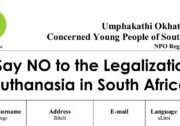The practice of euthanasia involves a doctor or physician prescribing a lethal drug for a patient who is terminally ill and who has requested that their life be ended.
Whilst people are divided on the issue, many of those who support “assisted suicide” or “assisted dying”, as euthanasia is also called, have founded their beliefs on several myths that surround the practice.
Myth 1 – Everyone has a “right to die”, including the right to take one’s own life
There is no recognized right to suicide that involves the cooperation of another person. The Supreme Court in the USA has denied that a constitutionally protected ‘right to commit suicide” exists. Whilst terminally ill people already have the right to refuse medical care should they wish to, no one has the ‘right’ to request a lethal way to end their own life.
Myth 2 – People who choose euthanasia usually do so because they are experience great pain and suffering
Data from the USA has shown that most requests for assisted suicide are not made by patients experiencing “terrible pain and suffering”. Rather, the most common reasons are loss of independence, not being able to take part in recreational activities and the loss of dignity.
Myth 3 – In states in the USA where euthanasia is legal, there are safeguards to protect patients from abuse
In several states, it has been reported that cases of negligence are hard to track, processes are open to abuse and room exists for patients to be pressured into requesting euthanasia. Poor laws surrounding euthanasia mean that the correct channels are being bypassed by patients and medical practitioners alike. Sufficient information regarding cases of euthanasia is not being accurately collected and reporting processes are being bypassed.
Myth 4 – In the USA, only people with terminal or incurable illnesses are able to request euthanasia
The laws surrounding euthanasia can be interpreted to include patients with far less severe illnesses, who if they refused medication would die within 6 months. Legislation is so broad that, technically, patients who suffer from insulin dependent diabetes and even anorexia could be eligible for euthanasia under existing laws!
Myth 5 – “Slippery slope” arguments against euthanasia are overblown, in countries that have legalized there is no evidence that patients are being euthanized improperly
People who suffer from non-terminal illnesses have been euthanized in certain countries for nearly the past fifteen years already. This includes many patients who suffered from purely psychiatric disorders. Some countries have already removed any distinction between terminally ill and non-terminally ill patients from legislation.
Between 2008 and 2014, 200 psychiatric patients were euthanized in the Netherlands. When applying for euthanasia, 66% of these cases indicated that they were requesting euthanasia due to “social isolation and loneliness.”
Myth 6 – Methods used in assisted suicide ensure the patient a quick, peaceful death, without serious complications
Reported complications have included a longer time to death than expected, awakening from unconsciousness, nausea, vomiting and gasping.
Data collected between 1998 and 2015 has shown that the time between the administering of lethal drugs and death varied between 1 minute and 4 days. 27 out of the 994 cases involved difficulty in ingesting the drugs and there were 6 known cases where patients regained consciousness after ingesting the drugs.
However, it is difficult to know the actual rate of drug induced complications as in 54% of these cases, no medical practitioner was present to observer the patient’s death.
Myth 7 – “Death with dignity” all comes down to the patient’s independence and the right of the patient to end their life on their terms
Whilst autonomy is one of the cornerstones of medical ethics, the others include kindness, justice and doing no wrong.
Myth 8 – Doctors who are opposed to euthanasia are free to refuse participating in it
An example is California’s health department regulations, which require that a state facility must provide for physician-assisted suicide (PAS). If a request by a patient is denied, that are entitled to a judicial hearing on the matter.
If the court determines that the patient is eligible, the attending physician must write a prescription for lethal drugs. Evidence does exist that physicians are in some cases pressurized or intimidated by patients to assist in suicide.
Myth 9 – Terminally ill people who are dying are not suicidal and do not commit suicide, they simply want ‘hastening’ of their inevitable death. Genuinely suicidal people are not dying of an illness, yet they want to die.
As the American Nursing Association states, “suicide is the act of taking one’s own life,” regardless of the context of the act. Therefore, when a terminally ill person, or any other person for that matter, knowingly and intentionally ingests medication that will kill them, it is suicide.
Most suicides do occur in the context of serious psychiatric illness. Yet patients who express suicidal ideation in the context of a condition such as major depression rarely want to die. Rather, they are experiencing severe emotional pain and are desperate for the pain to go away.
Myth 10 – People requesting euthanasia are carefully screened by mental health professionals to rule out depression
In most scenarios, statutes do not require an examination by a mental health professional unless the participating physician is concerned and requests an examination.
In 2016, 204 patients in Oregon, USA, were prescribed lethal drugs yet only 5 patients were sent for psychiatric or psychological screening.
Myth 11 – Doctors who participate in euthanasia are always comfortable doing so and rarely regret their decision
Many participating doctors are adversely affected, both emotionally and psychologically.
In an interview with 38 oncologists in the USA who had participated in euthanasia, nearly a quarter of the physicians regretted their actions. Another 16% reported that the emotional burden of performing euthanasia had negatively affected their medical practice.
One physician stated that he had felt so “burned out” that he moved from the city in which he was practicing to a small town.
Myth 12 – For terminally ill patients, the only means of achieving “death with dignity” is by taking a legal drug prescribed by one’s doctor
Only a small percentage of people with a terminal illness request euthanasia. Why would poisoning yourself to death bring dignity to person?
Many people who are dying choose to bear with their pain. Some seek hospice care and in cases of severe pain, some request palliative sedation.
There are existing options other than euthanasia already available to patients, many of which can be considered more ethical and dignified means of achieving a “natural” death.
The argument for euthanasia clearly rests on a number of popular misconceptions regarding its safety and adequacy. However, vulnerable members of the population are at risk due to legal loopholes and a lack of adequate monitoring.
The American College of Physicians, the American Medical Association, the World Medical Association and the American Nurses Association as well as medical bodies in many other countries, have registered their opposition to euthanasia and physician assisted suicide.



